My current research interests tend to focus on Arctic policy, sovereignty, security, and governance issues; modern Canadian and circumpolar history; war and society; and Indigenous-state relations in Canada. I have several major research programs on the go, as well as individual research projects.
The DEW Line: A Spatial History
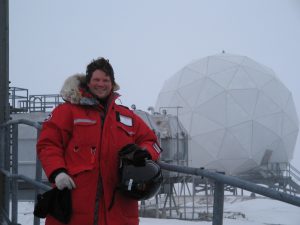 In 1953, the Cold War lodged in the minds of the North American allies and the polar projection map representing the geo-strategic realities of the nuclear age, the Canadian and United States governments began to undertake the largest construction project in polar history. The DEW radar line would extend nearly halfway around the circumpolar world, and bring massive amounts of southern construction equipment, materials, and men to the Canadian arctic. Drawing on archival materials and oral histories, this major project describes, explains, and assesses the design and implementation of the DEW Line project – and concomitant impacts on Northern peoples.
In 1953, the Cold War lodged in the minds of the North American allies and the polar projection map representing the geo-strategic realities of the nuclear age, the Canadian and United States governments began to undertake the largest construction project in polar history. The DEW radar line would extend nearly halfway around the circumpolar world, and bring massive amounts of southern construction equipment, materials, and men to the Canadian arctic. Drawing on archival materials and oral histories, this major project describes, explains, and assesses the design and implementation of the DEW Line project – and concomitant impacts on Northern peoples.
This project builds upon the substantial body of secondary literature that explores the nature and impacts of Northern development from historical, sociological, anthropological, economic, and political science perspectives. A SSHRC Standard Research Grant (2006-09) allowed us to hire research assistants to digitally copy and index more than 70,000 pages of unpublished primary documents from Canadian archival repositories and more than 60,000 pages from American institutions.
Pukiktalik / One Striped Like a Caribou: Historical Dimensions of Mounted Police-Inuit Relations in Inuit Nunangat, 1900-1970
While the Royal Canadian Mounted Police (RCMP) commemorates its 150th anniversary in 2023, Inuit leaders and senior federal officials seek to advance aaqigiarutiqarniq (reconciliation) between the police force and Indigenous Peoples. The challenges associated with this relationship are inextricably tied to histories of the introduction of colonial legal systems to Inuit Nunangat (the Inuit homeland in Canada) and the often overlooked or unrecognized contributions of Inuit in policing and exercising sovereignty in the region.
Inspired by recent books written or co-authored by Inuit that reinforce how Indigenous insights invite reappraisals of entrenched Canadian histories, this Inuit-Qallunaat collaborative research project seeks to advance knowledge about Inuit service with and in the RCMP and to critically reposition relationships between the Canadian state and Inuit in the first seven decades of the twentieth century. While “heroic age” literature on the Mounties celebrated their projection of sovereignty and imposition of colonial justice on Northern peoples, it downplayed Inuit experiences and contributions to policing and patrolling. Following the lead of scholars seeking to bridge disparate historical traditions and negotiate the tensions between documentary evidence and collective memory, our goal is to shift the historic lens and “re-read” the documents based on Inuit oral histories.
Our project builds upon initial work conducted by an Inuit heritage consultant and historians with extensive Northern relationships who recognize the advantages of pursuing collaborative research that leverages diverse perspectives and expertise to understand complex social and academic issues. Working closely with a team of student research assistants, we will pursue mixed methods research that brings the documentary record and oral history interviews into dialogue to fundamentally reevaluate Inuit-Qallunaat relations during the period of Sangussaqtauliqtilluta (“when people started to be persuaded to change their ways”). All of our work is animated by a deep commitment to respect and accommodate differences in values, cultural norms, and Inuit preferred communication and decision-making styles, and we intend to devise and implement new approaches to collaborative historical research and writing on Inuit-Qallunaat relations through community-engaged practices.
A co-authored monograph will provide the first systematic study of the Inuit “special constables” and their families who enabled the RCMP to communicate with Inuit and survive in Arctic conditions. Using archival research and oral history interviews in Nunavut and Kalaallit Nunaat (Greenland), a case study of the relationship between RCMP Constable Alfred Herbert Joy and Nukappiannguaq will elucidate the close partnerships forged between Mounties and Inuit special constables. Another case study will reconstruct and re-imagine the the Hudson Strait Expedition of 1927-28 from the perspectives of Inuit who accompanied the RCMP and military personnel on their journeys. We intend to co-develop and iterate our methodology and approach to these projects based on conversations with community members across Inuit Nunangat.
By revisiting seemingly narrow and conventional topics, our research will expose the roots of complicated relationships between Inuit, the state, and the police – relationships that were and are highly personal, intensely formal, foundational, and multi-directional. What Inuit saw and experienced was quite different than what the police and other Canadians perceived. Understanding the long-term implications of these distinct perspectives and different stories requires a deep exploration of personal relationships and the structures that conditioned them.
The first phase of the project seeks to enhance access to the records of the NWMP / Royal Canadian North West Mounted Police / Royal Canadian Mounted Police in Canada’s northern territories from 1894, when Inspector Charles Constantine and Staff Sergeant Charles Brown first ventured to the Yukon on a reconnaissance mission, until 1960. This includes transcribing and editing digitized versions of relevant sections from the RNWMP/RCMP annual reports, involving a team of undergraduate research assistants who are assisting with producing clean copies of this material. These reports offer a wealth of information on the Klondike gold rush; the police’s role in asserting sovereignty in the Arctic during the whaling era; the establishment and activities of detachments across the Arctic, from Herschel Island to the Bache Peninsula to Lake Harbour (Kimmirut); the roles of RCMP Special Constables (Inuit and First Nations personnel who served with the Mounties); and the many expeditions that Mounties undertook by dog team, ship (including the dedicated schooner St. Roch), and eventually airplane. The annual reports also contain deep insights into the role of the police in projecting government authority into the Arctic through their work in investigating murder cases in which Inuit killed qallunaat (non-Inuit). This material will be available open access, online, in various formats to reach academic and non-academic audiences. Subsequently, I hope to systematically index and code the text so that it can interface with other databases, including the Arctic memoirs project (which will include the many memoirs produced by Mounties who served in the North), document collections on landmark criminal trials in the Canadian North, and digitized archival finding aids and primary materials. In partnership with Northern Canadian historical societies and Indigenous organizations, we hope that this process will democratize access to stories about Northern Canadians, support genealogy work, facilitate historical social network analysis, and serve as a basis for further research on the Government of Canada’s activities in and projection of authority into the Canadian North.
Landmark Northern Canadian Criminal Cases and Trials
This research project involves the collection, transcription, and publication of archival material on investigations and legal proceedings related to landmark criminal cases in the Canadian North. The initial focus is on murder cases from the first half of the twentieth century, with particular attention to Inuit Nunangat. These proceedings offer fascinating insights into how Northern Indigenous peoples administered justice, cross-cultural expectations and relations, and the government’s perceived need to enforce criminal law as an assertion of sovereignty.
- The first volume, on the murders of RCMP Cpl. W. A. Doak and trader Otto Binder in 1922 at Tree River, and the subsequent trials and executions of Tatamigana and his young nephew Alikomiak, was published in 2017 as Arctic Show Trial: The Trial of Alikomiak and Tatamigana, introduced by Ken Coates and William R. Morrison, compiled by P. Whitney Lackenbauer and Kristopher Kinsinger, Documents on Canadian Arctic Sovereignty and Security (DCASS) No. 9.
- The second volume, on “Religious Frenzy” and the Application of Canadian Law: The Belcher Island Murders, 1941, with Corah Hodgson, was published in Fall 2020.
- The third volume, “It is necessary that they should understand that they are under the Law”: The Murder Trials of Sinnisiak and Uloqsaq, 1917, with Grace Chapnik , was published in 2023. It compiled the police reports, court records, and newspaper articles related to the trial of Sinnisiak and Uloqsak in 1917 for the murders of Oblate missionary priests Father Rouvière and Father Le Roux near Bloody Falls four years earlier.
- The fourth volume will cover the murders of Henry Radford and George Street at Bathurst Inlet in 1911.
- The fifth volume compiles the police reports, court records, and newspaper articles related to the murder of Robert Janes in 1923 near Cape Crawford and the subsequent trial of Nuqallaq.
Anyone interested in contributing a volume to this series should feel free to contact me.
Operation Gauntlet: The Canadian-Led Combined Operation against Spitsbergen, 1941
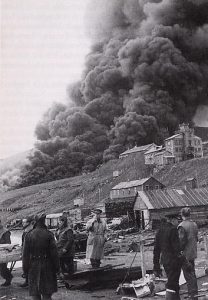 This project will produce the first in-depth study of one of Canada’s least known military operations: the raid on the Spitsbergen (Svalbard) archipelago in August and September 1941. This was the first major operation involving the Canadian Army Overseas outside of the United Kingdom after the withdrawal from France in June 1940. Brigadier A.E. Potts, the officer commanding 2nd Canadian Infantry Brigade, led a force of Canadian, British and Norwegian troops to destroy the coal mines on the island owned by Norwegian and Soviet interests. The force evacuated Russian and Norwegian foreign nationals, taking the former to the Soviet Union and the latter to Britain. In Russia, ships picked up French soldiers held as prisoners of war by the Soviets until the latter joined the Allied cause after the Nazi invasion of Russia.
This project will produce the first in-depth study of one of Canada’s least known military operations: the raid on the Spitsbergen (Svalbard) archipelago in August and September 1941. This was the first major operation involving the Canadian Army Overseas outside of the United Kingdom after the withdrawal from France in June 1940. Brigadier A.E. Potts, the officer commanding 2nd Canadian Infantry Brigade, led a force of Canadian, British and Norwegian troops to destroy the coal mines on the island owned by Norwegian and Soviet interests. The force evacuated Russian and Norwegian foreign nationals, taking the former to the Soviet Union and the latter to Britain. In Russia, ships picked up French soldiers held as prisoners of war by the Soviets until the latter joined the Allied cause after the Nazi invasion of Russia.
Although Canadian focused, this research will produce an international history that grapples with various military, political, socio-cultural, and environmental themes. Our study systematically documents and critically analyzes the origins, planning, execution, and lessons learned from Operation Gauntlet. This fits within a broad historiography on Canada and the world wars which includes many examples of detailed narratives on specific operations but has entirely overlooked this successful one, mainly because the Allies achieved their objectives without engaging in combat.
Exercise Musk Ox and the Making of the Modern Military North
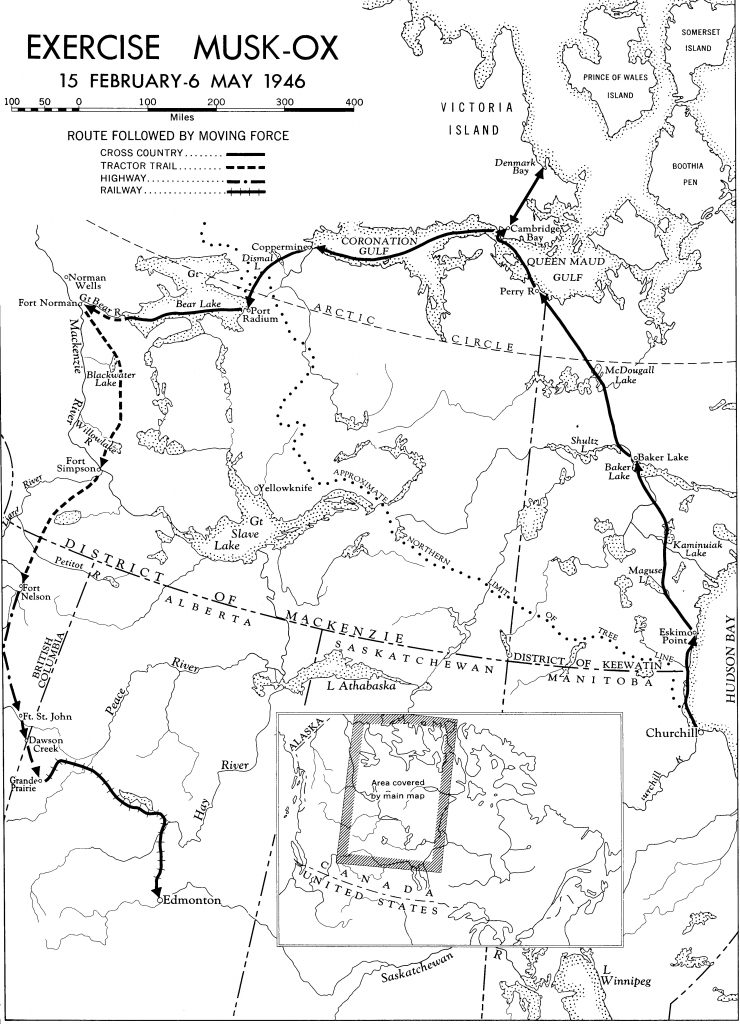 Exercise Musk Ox, conducted in 1946, straddles the hazy temporal boundary between the Second World War and the Cold War, as well as the “heroic” and “modern” eras of Arctic exploration. Unfolding under an intense national and international media spotlight, the exercise proposed to move a mechanized force across 3,000 miles of northern Canada. Although a military operation, the government tended to emphasize the scientific aspects of the expedition, with participants making magnetic and auroral observations, collected snow and ice data, and recorded the flora and fauna along the route. Various participants, several of whom went on to distinguished careers as polar scientists and senior civilian servants (such as Patrick Baird, Graham Rowley, and Tuzo Wilson), gathered extensive documentation on the exercise and, in some case, drafted memoirs of their experiences. None have been published, however, leaving Musk Ox a relatively unknown—but pivotal—Arctic expedition.
Exercise Musk Ox, conducted in 1946, straddles the hazy temporal boundary between the Second World War and the Cold War, as well as the “heroic” and “modern” eras of Arctic exploration. Unfolding under an intense national and international media spotlight, the exercise proposed to move a mechanized force across 3,000 miles of northern Canada. Although a military operation, the government tended to emphasize the scientific aspects of the expedition, with participants making magnetic and auroral observations, collected snow and ice data, and recorded the flora and fauna along the route. Various participants, several of whom went on to distinguished careers as polar scientists and senior civilian servants (such as Patrick Baird, Graham Rowley, and Tuzo Wilson), gathered extensive documentation on the exercise and, in some case, drafted memoirs of their experiences. None have been published, however, leaving Musk Ox a relatively unknown—but pivotal—Arctic expedition.
This book, which I am co-writing with Dr. Peter Kikkert, tells the story of Musk Ox, from its earliest conception on a train heading south from Churchill in April 1945 to its culmination with the soldiers parading through the streets of Edmonton on 6 May 1946. Although backed with all of the evidentiary rigour of a major academic study, we are writing this book in an accessible, narrative style that should make it attractive to popular audiences as well. Readers will follow the “Musk Oxers” from their preliminary winter training in Manitoba through their 3200-mile journey from Churchill, north to Eskimo Point, west and north via Baker Lake and Perry River to Cambridge Bay, on to Coppermine (Kugluktuk), then south through Port Radium, Tulita, and Fort Simpson to the Alaska Highway at Fort Nelson. The arrival of the vehicles and personnel in Edmonton, by train, marked the end of the physical expedition. The public and media reaction, however, continued to amplify the importance of the operation out of proportion to its actual designs, suggesting that it portended a new era in Arctic defence. For example, one French military writer outlandishly claimed that “since World War II two events have held the interest of military circles–Bimini [the American nuclear tests in the Pacific] and Operation Musk Ox in the Canadian Far North.” While the outcomes of Musk Ox were more modest than such hyberbole would suggest, this operation shaped early Cold War defence planning, stimulated dreams of Northern economic development and, through the people involved in it, set a trajectory for postwar Arctic sciences in Canada more generally.
Modern Explorers: US Maritime Operations and the Canadian Arctic, 1945-60
This book, which I am co-authoring with Dr. Adam Lajeunesse, will provide the first systematic analysis of U.S. naval task force activities in the Canadian North from 1946-60. These modern “exploratory“ voyages charted new passages, yielded ground-breaking scientific information, and shaped logistic, transportation, and settlement patterns. They also led Canada and the US to collaborate and manage disagreements over Arctic sovereignty. Focusing on US sources previously unexplored by historians, this book will shed new light on why the joint defence relationship was so successful.
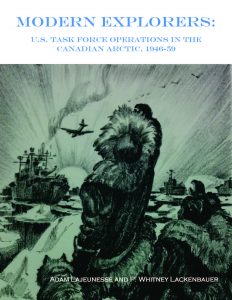 Existing scholarship tends to examine bilateral relations from a Canadian perspective or, in the case of several recent M.A. theses, from the perspective of high-level American politicians and senior strategists. This book shifts the focus to examine bilateral cooperation through an American operational lens. By acknowledging the US fixation on what it perceived as practical requirements to access the region, we will undertake the first in-depth look at US maritime operations in Canadian Arctic waters in the early Cold War. Between the end of the Second World War and the completion of the Distant Early Warning (DEW) Line, the US Navy’s Military Sea Transportation Service and the US Coast Guard sent dozens of icebreakers and cargo ships to the waters of the Arctic Archipelago. (The Royal Canadian Navy lacked the heavy icebreakers or specialized landing craft needed to build and maintain postwar joint defence projects, making the American presence a practical necessity.) Accordingly, American vessels completed most of the early postwar charting and surveying in the region, transported materiel and personnel to establish radar and weather stations, and resupplied Canadian and American forces stationed in the Arctic Islands.
Existing scholarship tends to examine bilateral relations from a Canadian perspective or, in the case of several recent M.A. theses, from the perspective of high-level American politicians and senior strategists. This book shifts the focus to examine bilateral cooperation through an American operational lens. By acknowledging the US fixation on what it perceived as practical requirements to access the region, we will undertake the first in-depth look at US maritime operations in Canadian Arctic waters in the early Cold War. Between the end of the Second World War and the completion of the Distant Early Warning (DEW) Line, the US Navy’s Military Sea Transportation Service and the US Coast Guard sent dozens of icebreakers and cargo ships to the waters of the Arctic Archipelago. (The Royal Canadian Navy lacked the heavy icebreakers or specialized landing craft needed to build and maintain postwar joint defence projects, making the American presence a practical necessity.) Accordingly, American vessels completed most of the early postwar charting and surveying in the region, transported materiel and personnel to establish radar and weather stations, and resupplied Canadian and American forces stationed in the Arctic Islands.
This book illuminates the practical experiences of icebreaker crews as well as the “lessons learned” that they generated while overcoming operational challenges as well as political ambiguity and sensitivity over sovereignty. Even with the benefit of “modern” technology, ships were frequently damaged during these voyages and captains begrudgingly accepted that they had to adapt or yield to environmental conditions. Accordingly, we will carefully examine how the nature of “exploration” and maritime activity in the Arctic Archipelago changed because of technology, improved capabilities, and experiential knowledge. Over time, the size and scope of Arctic convoys grew, requiring innovative planning, elaborate preparations, and complex joint (Canada-US) interdepartmental/interagency coordination. These “modern voyages” made an expanded security footprint in the Arctic possible and facilitated the establishment and sustainment of stations in parts of the Arctic that were hitherto inaccessible to non-Inuit. These operations culminated with the construction of the DEW Line, the largest construction project in the history of the North American Arctic.
American Arctic operations must be situated within a delicate (and even volatile) political context of Canadian sovereignty sensitivities. Although the US acknowledged Canadian terrestrial sovereignty over the islands of the Arctic Archipelago during this era, the escalating tempo and scale of maritime activities in the waters between the islands raised questions about who had the right to control activities therein. American officials and crews discerned ways to balance Canadian efforts to micro-manage activities with the crews’ practical need to retain the necessary flexibility to operate effectively in the challenging Arctic maritime environment. We are interested in learning how American officials managed or sidestepped sensitive sovereignty issues, and our preliminary evidence suggests that creative diplomacy and accommodation overcame the inevitable friction caused by American interest and activities in sparsely populated or unpopulated parts of the Canadian Arctic.
Pullen of the Arctic
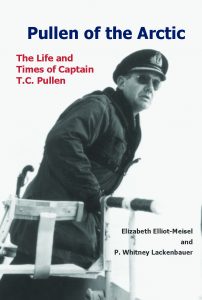 With Elizabeth Elliot-Meisel of Creighton University (Nebraska), I am currently researching and writing a biography of Thomas Charles Pullen (1918-1990). A fifth generation naval officer, Pullen commanded numerous ships during his career with the Royal Canadian Navy (RCN) from 1936-65. He became a noted authority on and explorer of the Arctic after he took command of the naval icebreaker HMCS Labrador in 1956. Retiring after thirty years of active naval service, Pullen went on to serve as an advisor and consultant to government and industry on arctic marine operations for another twenty-four years. Over the course of his life, “Pullen of the Arctic” – as he became widely known — earned the reputation as North America’s foremost expert on Arctic navigation and icebreaking.
With Elizabeth Elliot-Meisel of Creighton University (Nebraska), I am currently researching and writing a biography of Thomas Charles Pullen (1918-1990). A fifth generation naval officer, Pullen commanded numerous ships during his career with the Royal Canadian Navy (RCN) from 1936-65. He became a noted authority on and explorer of the Arctic after he took command of the naval icebreaker HMCS Labrador in 1956. Retiring after thirty years of active naval service, Pullen went on to serve as an advisor and consultant to government and industry on arctic marine operations for another twenty-four years. Over the course of his life, “Pullen of the Arctic” – as he became widely known — earned the reputation as North America’s foremost expert on Arctic navigation and icebreaking.
Securitization and Sovereigntization of the Canadian Arctic
A primary objective of my overarching research program is to explore the interplay between sovereignty and security – and more precisely securitizing and sovereigntizing moves – in Canadian state practice since the end of the Second World War. Through a series of case studies grounded in mixed qualitative evidence (government documents, scholarly and popular literature, archival material, and interviews), I continue to critically assess how the identification and definition of sovereignty and security threats reflect evolving international and domestic contexts. How did various political, diplomatic, military, academic, media, and other stakeholders perceive and construct threats, and is this reflected in the present discourse? How are threat images diffused or translated to new (inter)national contexts? How should past and ongoing policy processes inform future policy-making?
My primary analytical framework will be securitization theory. First developed by the so-called “Copenhagen School” in the 1990s, the theory posits that a security issue is produced after a securitizing actor presents it as an existential threat and convinces the “audience” that this is the case. The “pioneers” of this approach, Barry Buzan, Ole Weaver and Jaap de Wilde, identify three units of analysis: the referent object (the object of securitization); the security actor (actors who declare a referent object to be existentially threatened); and functional actors (actors who significantly influence decisions in the security sector). Building on Thierry Balzacq, I concur that audiences and context are also essential units of analysis to understand the practices and methods that produce security.
My broad study will employ aspects of both the theoretical model of securitization to help explain the creation of security threats, and the sociological model of securitization to understand the construction of threats as pragmatic practice to attain political or policy goals. In moving beyond the poststructuralist model of the Copenhagen School, I draw upon the strengths of this critical linguistic approach without denying the benefits of applying more positivist research techniques to cases under study.
While the concepts of security and sovereignty are often intertwined in recent discourse, there is a salient distinction with the latter referring to concepts of legal ownership and the right to control activities in a given jurisdiction. In Canada, external actors – particularly the United States – have been conceptualized as threats to Canada’s Arctic sovereignty, but not as security threats. For analytical purposes, the logic of securitization theory (moves, actors, context, and audience) also applies to the production of sovereignty threats. Accordingly, I will develop and test a parallel model of sovereigntization (building on the political sector of securitization theory) to explain non-“security” threat construction and practices mobilized to protect Canadian terrestrial and maritime sovereignty (the referent object). The interplay between these securitizating and sovereigntizing moves cannot be captured by relying on existing theory.
My particular interest lies in exploring how securitizing and sovereigntizing moves influence the development of policy tools or instruments related to defence, diplomatic engagement, and international law. In laying out criteria to assess the success or failure of these moves, I am particularly attentive to the functional arguments they intend to serve. When did the Canadian government turn to regulatory tools (processes of governmentality) and when did it turn to capacity tools (specific modalities for imposing external discipline) to attain desired policy outcomes? What resources was it willing to invest in these tools, to what ends, and for how long? Did securitizing moves succeed or fail to influence policy since the Second World War – and why?
Securing Sovereignty? Canada, the U.S., and the Arctic, 1946-55
With historian Peter Kikkert, I am completing a book on Securing Sovereignty: Canada and the Early Cold War Arctic for a Canadian university press that will re-evaluate Canadian policy-making from 1946-1955 through in-depth analysis of the archival record. With careful attentiveness to context, our preliminary findings indicate a qualified case of successful securitization of the region but a failed case of sovereigntization (despite the exhortations by contemporary journalists and subsequent scholars like Grant that Canadian sovereignty was gravely imperilled). More nuanced analysis of the archival record indicates that Canadian and American officials engaged in quiet diplomacy through established diplomatic and military channels and ultimately set a mutually satisfactory course. Indeed, it appears that Canada secured greater American recognition of its Arctic sovereignty than previously without deviating from “normal” political channels. As such, this case study will allow us to shed light on the logic of securitizing and sovereigntizing moves in the early postwar period, analyze discourses, and better understand the policy instruments adopted to balance security and sovereignty imperatives. The monograph will end in 1955 with the bilateral agreement for the construction of the DEW Line, which integrated the lessons learned over the previous decade.
(Re)Securitization of the Arctic: From the End of the Cold War to Present
Scholars typically describe the desecuritization of the circumpolar agenda in the 1990s. While there was certainly a diminished emphasis on traditional military security challenges, my preliminary research suggests that this period is better conceptualized as an era of a re-securitization. Although officials clearly believed that constructive engagement with Arctic neighbours, not confrontation, would mark the twenty-first century, the retention of the language of security (by broadening and deepening it) remains important in explaining what transpired in the last two decades.
The key debate over the last decade has revolved around two basic positions. (Neo)Realists argue that uncertainty and growing tensions amongst the Arctic states could result in military conflict. Proponents of liberal internationalism/ neoliberalism hold that the Arctic system is developing in an orderly fashion founded on international law and principles of cooperation. They argue that there is a stable legal regime in the Arctic, and soft law institutions like the Arctic Council serve as important fora for constructive international engagement and cooperative management. By extension, they postulate that the greatest security threat to the Arctic may come in repeated efforts to frame the debate in terms of conflict — that there is little likelihood of interstate conflict, unless the issues are securitized by adopting a discourse of crisis. In their assessment, the existing issues regarding Arctic security are challenges that can be managed diplomatically as long as their importance is not overstated and politicized by misapplying concepts of national security and sovereignty. Canadian policy since 2005 reflects both of these viewpoints.
To document these trends and issues, I am organizing an edited book that charts sovereigntizing and securitizing moves since the end of the Cold War. The chapters will reflect different disciplinary approaches while adhering to the sovereigntization/ securitization framework at the heart of this research program. The authors (including graduate students and postdoctoral fellows) will critically analyze who designated particular “threats” and assess the successful or failure of these speech acts. With careful attentiveness to context, the authors will critically analyze academic debates, political statements, testimonies before parliamentary committees, and media coverage to interrogate the language, analogies, euphemisms, symbols, and rationales that securitizing, sovereigntizing, and functional actors have mobilized to convince relevant national audiences that there are (or are not) sovereignty and security threats requiring an exceptional response. To situate these insights in broader and deeper context and determine their influence on audiences, we will also interview key policy-makers.
The culmination of this research program involves the completion of a comprehensive monograph for a Canadian university press that articulates the theoretical framework (as it has evolved in dialogue with our empirical findings) and applies it systematically to Arctic sovereignty and security discourse and state practices in Canada since 1900. I will be co-lead author on this study with a political scientist, supported by the postdoctoral researchers who will act as co-authors. My goal is to produce a summary that can be used in fourth-year undergraduate seminars and graduate courses, while remaining interesting, innovative and informative to specialists in various disciplines and fields.
A Comprehensive Approach to Canadian Security and Safety in the Arctic: Meeting Probable Challenges and Practical Responsibilities in a Whole-of-Society Context
The Arctic has emerged as a topic of tremendous hype (and deep-seated misperceptions) over the past decade, spawning persistent debates about whether the region’s future is likely to continue along cooperative lines or spiral into unbridled competition and conflict. Although official Canadian assessments do not anticipate any conventional military threats to the region, they do foresee a rise in security and safety challenges that require an integrated Whole-of-Government (WoG) and Whole-of-Society or Comprehensive Approach as new development projects and trade routes emerge. This requires a more nuanced and multifaceted definition of security than what typically has been a narrow, academic fixation on the possibility of inter-state conflict in the region.
Lasting solutions to complex Arctic security and safety challenges (such as natural or human disasters, environmental dumping, increased search and rescue (SAR) incidents, espionage, organized crime, or pandemics) require a system-wide, multifaceted response that integrates a wide range of civilian and military resources. While other departments and agencies are the mandated leads to deal with most Arctic security issues in Canada, the military is expected to “lead from behind” in many scenarios given their assets/capabilities and the limited resources of other potential responders in the region. This entails a reconceptualization of the Arctic security landscape, moving away from a fixation on the international military threat environment (which strategic planners assess as low-risk) towards practical questions related to operational challenges and the need for rapid, coordinated responses to other security and safety challenges related to the environment, transportation, resource development, and community safety.
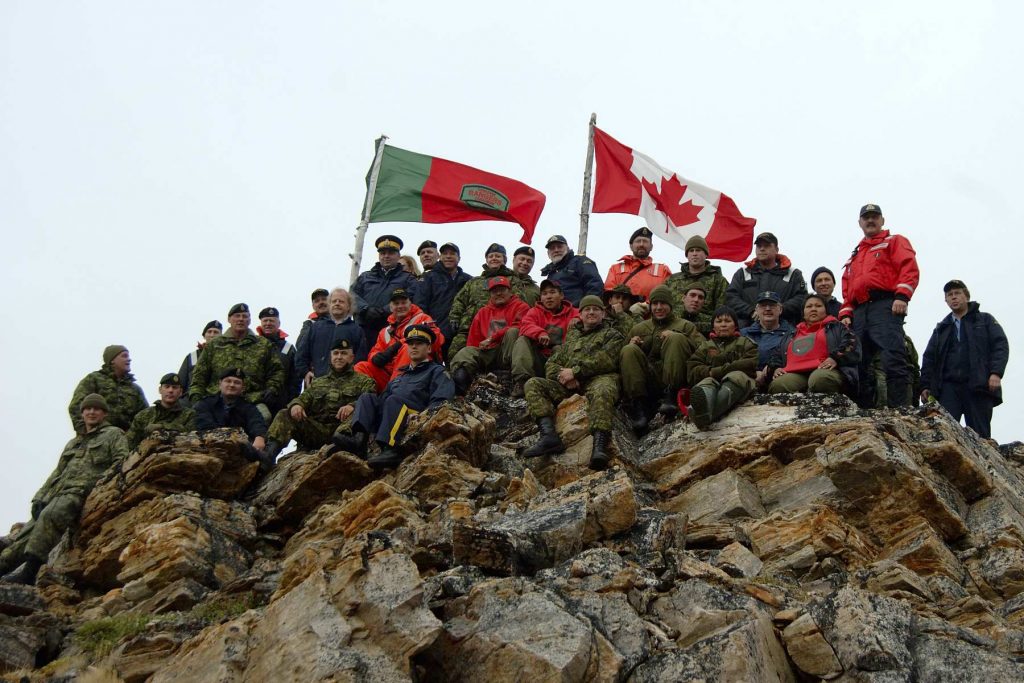
The WoG framework has emerged as a centerpiece of Canada’s Arctic policy because it offers a way to rationalize services and leverage capabilities across government(s). The concept is predicated on enhanced horizontal coordination between government departments and agencies (and, in some cases, non-government stakeholders) to cut across traditional institutional silos and achieve a shared goal. Although the concept is simple, its implications are significant – and how government departments and agencies actually implement and exercise a WoG directive is far from straightforward in practice. Nevertheless, given the dearth of infrastructure and limited government capacity in the Arctic, cooperation is a prerequisite to effective operations.
Efforts to create inter-departmental and international synergies to prepare, coordinate, and respond to practical security and safety challenges in domestic and circumpolar Arctic contexts remain a work-in-progress. Despite the emphasis placed on WoG in official policy statements, operations over the last decade reveal myriad barriers to effective integration and linking of government, local, and private sector partners. These obstacles include a lack of designated funding for initiatives that cut across departmental or government lines, policy structures that do not align (particularly across the civilian-military divide), and jurisdictional silos that inhibit (or prohibit) collaboration. In the case of the Canadian Arctic, implementation requires fundamentally altering military and public sector cultures, including chains of command, procedures, channels of communication, and even issues of terminology and vocabulary. While interdepartmental committees in Ottawa and the Arctic Security Working Group in Yellowknife encourage collaboration between federal departments and other stakeholders on security initiatives, significant friction and gaps remain that inhibit operational efficiencies and effectiveness. Furthermore, federal stakeholders must collaborate with sub-national and Aboriginal governments that have their own priorities and needs.
Discussions with Canadian and American federal, territorial and Northern community stakeholders pursuant to the ArcticNet Emerging Arctic Security Environment project that I co-directed from 2011-15 confirm that, despite the tremendous emphasis placed on comprehensive approaches to security in policy statements by the Arctic states over the past decade, national and sub-national “silos” remain largely intact and lessons from operations and exercises have not been fully absorbed. In part this reflects established institutional cultures that are resistant to change, and indicates a persistent inability to discern and disseminate lessons through government mechanisms. By gathering and analyzing new empirical evidence, and bringing it into dialogue with existing scholarship and theoretical insights, our academic team hopes to clarify and inform how academics and policy-makers envisage, implement and sustain comprehensive security and safety approaches that can have direct, positive policy and practical benefits for governments and for Northern communities.
Given the multidimensional nature of emerging Arctic challenges, we adopt definitions of Arctic security that move beyond traditional frameworks focused on potential inter-state military conflict to emphasize broader human and environmental issues that government and Northern representatives identify as the most pressing security and safety concerns. These include SAR, major transportation disasters, environmental disasters, loss of essential services (eg. potable water, power, and fuel supplies), organized crime, foreign state or non-state intelligence gathering activities, attacks on critical infrastructure, food security, and disruptions to local hunting and transportation practices caused by shipping or resource development. While theoretical frameworks often suggest a dichotomy between narrow, elite-centred, interstate concepts of security and broader understandings of community or human security rooted in individuals or subordinated groups, our research indicates that defence-related activities and relationships in the Canadian Arctic do not always conform to the “militarized and violence-focused terms” that many scholars associate with a military presence. Rather than positing military and human security agendas in conflict, we seek to offer critical academic guidance that supports efforts to develop a collaborative, culturally-complex WoG paradigm to address emerging threats and hazards in the twenty-first century circumpolar world.
Although we approach the topic from a Canadian perspective, our research programme is inherently international in orientation and seeks to critically examine “lessons learned” from, and to discern opportunities for partnership with, other Arctic states. Pursuant to this project, I have co-edited a volume with Dr. Heather Nicol of Trent University on Whole of Government through an Arctic Lens, and authored or co-authored several papers on the Whole of Government approach to Arctic security.
Canada’s Northern Strategy and the Circumpolar Arctic from Trudeau to Trudeau
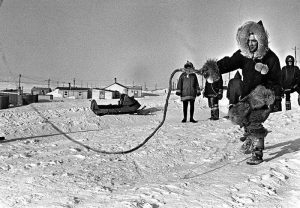
Prime Minister Pierre Trudeau tries cracking a dog sled whip while visiting Baker Lake in the Arctic, March 10, 1970. (CP PHOTO/ Peter Bregg)
The Arctic continues to occupy a distinctive place in Canada’s national identity. Rich symbolism, imagery, and mythology casts the Arctic as a resource-rich “frontier of destiny,” a homeland for indigenous peoples, a fragile environment in need of protection, and a source of national inspiration. Accordingly, Canada’s ongoing dilemma is how to balance sovereignty, security and stewardship responsibilities in a manner that protects and projects national interests and values, promotes sustainable development and healthy communities, and facilitates circumpolar stability and cooperation.
International developments over the last decade have drawn unprecedented political and popular attention to Arctic affairs. Uncertainty over climate change, international interest in Arctic resources, undefined continental shelf boundaries, potentially viable maritime transportation routes (particularly the Northwest Passage), and perceived sovereignty and security threats make Canadians keen observers of geopolitical dynamics related to the Arctic and what these mean for their foreign, defence, and domestic policies. At the highest political levels, the Canadian government has intertwined sovereignty issues with strong rhetoric asserting Canada’s status as an “Arctic superpower.” But for all the attention that hard-line rhetoric generates in the media and in academic debates, this discourse is only one part of a more complex picture.
A more positive and constructive message emerges from Canada’s official Northern Strategy and Arctic foreign policy statements, which emphasize confidence in Canada’s sovereignty position and the need to improve the social and economic well-being of northern residents (particularly Indigenous Canadians); promise to advance measures for environmental protection and sustainable development; and commit to enhance governance and international cooperation. I will argue that our Northern Strategies have reflected consistent themes and areas of emphasis since the 1970s, balancing sovereignty, national security, and domestic social, political, and economic interests with the goals of international stability, cooperation and stewardship. By looking at the evolution of Canada’s Northern strategies over the past half century, this book will reveal how and why Canada’s perspectives and positions on Arctic issues are more long-standing than most Canadians appreciate, and how they offer a solid foundation for constructive circumpolar engagement as a country (regardless of which party is in power in Ottawa) in partnership with Northern Indigenous peoples.
A History of the Pacific Coast Militia Rangers
In Canada, the study of civil-military relations is often confined to relationships between politicians and senior defence officials in Ottawa and Washington. I am interested in intensely local relationships: the military’s historic and continuing footprint in communities across Canada.
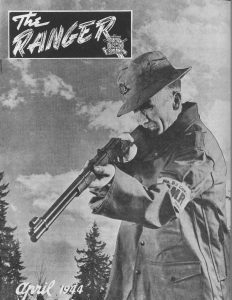 My research on the Canadian Rangers drew me to the story of their immediate predecessors, the Pacific Coast Militia Rangers (PCMR), who were organized in communities along the Pacific Coast and in the British Columbia interior during the Second World War. I am co-authoring a book on the topic with Kerry Steeves, who completed an M.A. thesis on the topic in 1990 based on extensive interviews with former Rangers and is now a librarian at the University of British Columbia. We illuminate a partial and decentralized militia force that served the war effort in unorthodox but useful ways. Furthermore, it reinforces how identities are constructed through the interaction with and response to particular environments. Men who could not serve overseas for reasons of age, occupation, or disability still had military space in which to operate – and inscribe their identities – through their special relationship with a local and familiar place.
My research on the Canadian Rangers drew me to the story of their immediate predecessors, the Pacific Coast Militia Rangers (PCMR), who were organized in communities along the Pacific Coast and in the British Columbia interior during the Second World War. I am co-authoring a book on the topic with Kerry Steeves, who completed an M.A. thesis on the topic in 1990 based on extensive interviews with former Rangers and is now a librarian at the University of British Columbia. We illuminate a partial and decentralized militia force that served the war effort in unorthodox but useful ways. Furthermore, it reinforces how identities are constructed through the interaction with and response to particular environments. Men who could not serve overseas for reasons of age, occupation, or disability still had military space in which to operate – and inscribe their identities – through their special relationship with a local and familiar place.
Indigenous Voices of the World Wars: Letters and Documents from the Canadian Department of Indian Affairs Archives
During the world wars, thousands of Indigenous men and women voluntarily enlisted in Canada’s armed forces, serving with other Canadians in every theatre in which Canadian forces took part. These wartime experiences shaped the contours of post-war Canada and informed Indigenous relations with the Canadian state. From the stories of individuals serving within Canada and on the front lines of Europe, to communities and families left to cope with their husbands and sons overseas, Indigenous peoples helped to co-author the story of the Canadian contribution to both world wars.
This project will identify, transcribe, and annotate letters of Indigenous people in Canada or serving overseas during the world wars. Initially, the project will look at content from the First World War, curating the material for publication in an open-access, edited volume. A collaborative effort with Ph.D. student Tim Clarke and undertaken with the support of the Canadian Aboriginal Veterans’ and Serving Members Association, the project will provide fresh insights into Indigenous people’s and peoples’ motivations for participation in the world wars, as well as aspects of their frustration with the Canadian state’s approach to “Indian policy” during the war years.
The fundamental goal of the project is to disseminate first-person perspectives (letters from the archives) for education purposes. The project will also contribute to the existing scholarship on Indigenous participation in the world wars by centring on Indigenous voices and by highlighting the varied responses that came from within Indigenous communities. To this end, the authors will contribute an introduction and conclusion to contextualize the letters and situate them within the academic literature on Indigenous participation in the world wars.
From a methodological standpoint, formal interviews with the veterans of the world wars are no longer possible. As such, the project will allow Aboriginal voices to speak directly from the archives – with our contribution focusing on providing context (both the wartime events or issues being discussed, as well as cultural frameworks). These letters contain the individual stories of veterans as well as important insights into the effects of enlistment on family life and sustenance, community resilience and relations with the Canadian state, appeals by servicemen and their families for equal and fair treatment by the Canadian government, and changing aspects of Indigenous ways of life in wartime.
The authors undertake this project with Call to Action #62 of the Truth and Reconciliation Commission as the guiding principle, especially to produce Education for Reconciliation by offering “curriculum on residential schools, Treaties, and Aboriginal people’s historical and contemporary contributions to Canada.”
EDITING PROJECTS
A Historical and Legal Study of Sovereignty in the Canadian North, volume 2: 1939-45, by Gordon W. Smith
Gordon W. Smith devoted most of his working life to the study of Arctic sovereignty issues. In the year that followed Dr. Smith’s death, his executors undertook to preserve the original manuscript of his unpublished magnum opus, A Historical and Legal Study of Sovereignty in the Canadian North and Related Law of the Sea Problems. In 2008, the Department of Foreign Affairs and International Trade asked Professor Armand de Mestral, Jean Monnet Chair in the Law of International Economic Integration in the Faculty of Law at McGill University, and myself to assess the value of Smith’s work and the extent to which its sources remained classified, with an eye to the possibility of making it available to the public.
Since that time, I have edited the first volume of his 1973 manuscript on terrestrial sovereignty issues from Confederation through to 1940 for publication with the University of Calgary Press. This book won several awards, including the 2014 John Lyman Book Award (North American Society for Oceanic History), Keith Matthews Award for 2015 (Canadian Nautical Research Society), and 2015 Alberta Book Publishing Awards: Scholarly and Academic Book Award. I hope that publishing Dr. Smith’s main research findings, as he wrote them but with extensive editing to redact his material to manageable length, will establish his important place in the historiographical and policy landscape on Arctic sovereignty issues. Furthermore, making his writings available to students, scholars, and policy-makers will serve as a strong basis for subsequent research into the development of Canada’s sovereignty position through to the late 1940s.
The Making of Landmark Arctic Agreements, Assessments, and Declarations
This edited collection will feature recollections by key participants in or authors of landmark Arctic agreements, assessments, and declarations, or chapters written by scholars based upon archival records, contemporary media and academic literature, and interviews with key stakeholders, to provide greater clarity into the processes that have shaped Arctic governance. Potential Chapters include: Agreement on the Conservation of Polar Bears (1973); Article 234 of UNCLOS; Gorbachev Murmansk speech (1987); 1988 Canada-US Arctic Cooperation Agreement; US-USSR Maritime Boundary Agreement (1990); The Arctic Environmental Protection Strategy (1989-1991); The Arctic Council; Arctic Climate Impact Assessment (2003); Arctic Marine Shipping Assessment (2009); Circumpolar Inuit Declarations on Sovereignty in the Arctic (2009) and Resource Development Principles in Inuit Nunaat (2011); Russia-Norway maritime boundary agreement (2010); Agreement on Cooperation on Aeronautical and Maritime Search and Rescue in the Arctic (2011); and Agreement on Cooperation on Marine Oil Pollution, Preparedness and Response in the Arctic (2013)
Great Speeches on the Canadian Arctic
This book will reproduce the texts of landmark Canadian speeches on the Arctic since Confederation.

